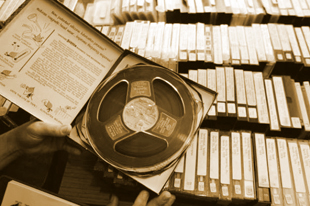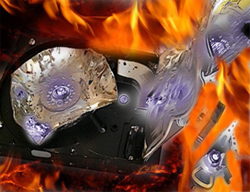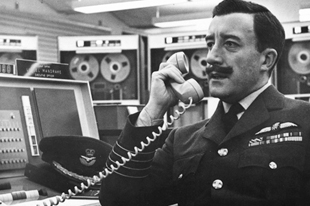![]() The EMP accompanying a nuclear strike would mark the end of any magnetically recorded music within its reach – tape, disk or solid-state. If it targeted the traditional centres of music recording, it could wipe the recording industry’s archive of multitrack and master tapes clean. Welcome to the real No Music Day.
The EMP accompanying a nuclear strike would mark the end of any magnetically recorded music within its reach – tape, disk or solid-state. If it targeted the traditional centres of music recording, it could wipe the recording industry’s archive of multitrack and master tapes clean. Welcome to the real No Music Day.
Termed ‘radioflash’ in British nuclear tests of the 1950s, an Electromagnetic Pulse is an archivist's nightmare. But it's not the only thing that costs them sleep...
It is unlikely that the bulk tape erasing properties of nuclear weapons occurred to the minds of the Manhattan Project, but it is an inescapable side-effect of their wartime development of the atomic bomb. Setting aside its other implications, the Electromagnetic Pulse (EMP) generated by a nuclear detonation could have been designed to give pro audio a seriously bad time – especially where its mag tape habit is concerned.
There is, however, a very real magnetic threat to our recordings.
In 1989, a solar storm caused a ‘complete, province-wide blackout’ in Quebec. It achieved this in just 92 seconds, and kept Quebec in the dark for nine hours. Worryingly, it was exactly the kind of magnetic anomoly as is created by an EMP. With sunspot activity now on the rise and in the news, the space weather forecast for the coming ten years is officially ‘unsettled’...
These solar storms are triggered (somehow) by sunspots and send coronal mass into space. Those that come Earth’s way are quite capable of playing havoc with our electrical and magnetic technology on a massive scale.
Weapons of mass deletion
 Admittedly, the likelihood of anyone nuking London, New York, LA and Nashville simply to rid the world of music is low, regardless of how effective it might be. I’m hopeful that it is beyond the current resources of the Taliban, and their animosity towards music. But other threats to archive recordings are not in doubt.
Admittedly, the likelihood of anyone nuking London, New York, LA and Nashville simply to rid the world of music is low, regardless of how effective it might be. I’m hopeful that it is beyond the current resources of the Taliban, and their animosity towards music. But other threats to archive recordings are not in doubt.
Along with those precious demos and the mixtapes you keep as mementos of your youth, a suitably targeted series of nuclear strikes would be the end of the recording industry’s taped history. The only exception would seem to be tapes held in screened storage – the kind of protection offered by Sony’s Iron Mountain facility in Poughkeepsie.
Here in upstate New York, careful control of temperature, humidity, lighting and dust (among other considerations) join the high iron content of the rock to protect the treasures of the music and movie industries, where they rest like spirits or mythical heroes awaiting a call to action.
If I had been in any doubt about the care lavished on old and classic recordings, visiting the archive room at Sony’s Manhattan studios clued me in. Here, in a single room were masters of some of the most influential and inspirational artists ever to see a microphone. In a room beyond were their celluloid equivalents. I got to hold the master to Kind of Blue but the fire risk associated with old film stock kept me from seeking out The Anderson Tapes, let alone Dr Strangelove.
Accompanying the recent re-releases of Pink Floyd’s Dark Side of the Moon, a BBC radio documentary saw producer Steve Levine journeying through some of Floyd’s multitracks. Early versions of ‘The Great Gig in the Sky’, the unmistakable Leslie piano note that opens ‘Echoes’ and ‘The Travel Sequence’ that became ‘On the Run’ made fascinating listening. But not every tape of interest can be played, as some are in too poor condition to survive a physical encounter with a tape deck... as a result of their storage.
 Binder failure isn’t the only archive consideration for mag tape, however. Other problems include poor winding, edge frilling, ‘country laning’ and vinegar syndrome (as thoroughly documented by Richard Hess in an Association for Recorded Sound Collections Journal paper from 2008). OK, this isn’t radioflash at work, but it indicates the severity and extent of the archival issue.
Binder failure isn’t the only archive consideration for mag tape, however. Other problems include poor winding, edge frilling, ‘country laning’ and vinegar syndrome (as thoroughly documented by Richard Hess in an Association for Recorded Sound Collections Journal paper from 2008). OK, this isn’t radioflash at work, but it indicates the severity and extent of the archival issue.
Archival considerations played a large part in the development of the recordable CD. Among those who have invested heavily in developing storage media is HHB (whose professional line of DAT tapes came out particularly well in accelerated ageing tests conducted by Studio Sound during my time as editor). The concurrent development of high sample rates and longer wordlengths (faster and wider...) was no coincidence. HHB helped bring pthalocyanine dye CD-R to the market, raising the stakes over the Orange Book cyanine standard. With the problems caused by binder failure on many tapes – requiring them to be baked to keep the oxide from shedding when they were played – high on the pro audio agenda, there was a lot riding on the longevity of the media lining up to replace analogue tape in the 1990s.
Cloud cover
But those physical media – tapes and discs – are giving way to a growing move towards hard drive storage. With the price of portable storage devices [now climbing towards 2Tb in capacity] becoming increasingly reasonable, they are the standard storage medium for many people.
 Recent upsets in the supply of hard drives from Thailand aside, other people are nervous about the security they offer. Among them is Mike Gitig, VP of Business Development at audio project management service Gobbler.
Recent upsets in the supply of hard drives from Thailand aside, other people are nervous about the security they offer. Among them is Mike Gitig, VP of Business Development at audio project management service Gobbler.
‘Ed Cherney showed Chris [Kantrowitz, Gobbler founder] a couple of hard drives. They contained the only copies of Rolling Stones albums – no back-up…’
‘The scary truth is that your hard drive can die at any time,’ Kantrowitz warns.
And back-up alone is not the full solution. To date, specialist archive facilities have been physical spaces designed to offer optimum conditions and security for physical media – as with Iron Mountain and The Hollywood Vaults. But as cloud computing passes from academic exercise to real-world commodity, it opens the door to an alternative approach to storage and accessibility. And possibly archiving.
Possibly, because attention is pretty focused on storage and delivery at present, as with the delivery service provided to major record labels by cloud service specialist interoute.
‘Your music files will be comfortable among those of EMI, Sony Music and Universal Music,’ interoute Hosting Business Development Director, Dirk Wehler, assures me. ‘They are streamed over the largest fibre network in Europe from a storage environment customised for its business purpose. They are quite safe because they are replicated to a business continuity datacentre on a fast, dedicated storage interconnection.’
 Although not devised as archive facilities, the nature of both cloud storage in general and Gobbler specifically give them many of the required features – principally off-site storage and redundant back-up. But there is more to archiving than redundancy: ‘We’re not quite there yet,’ says Gitig. ‘We talk about it, but it’s not 100 per cent.
Although not devised as archive facilities, the nature of both cloud storage in general and Gobbler specifically give them many of the required features – principally off-site storage and redundant back-up. But there is more to archiving than redundancy: ‘We’re not quite there yet,’ says Gitig. ‘We talk about it, but it’s not 100 per cent.
‘We can provide redundant, off-site secure storage but that’s not the same as a long-term archive,’ he explains. ‘An effective archive relies on being able to recover earlier file formats, so the question is how we do that in a digital world. Can we develop a virtual version of Pro Tools in order to read PT files? We are presently looking at open-source formats as an option. But I think it’s still three-to-four years off. And the future may depend on who owns the solution – it is possible that someone will come up with a solution and want to build a wall around it.’
At present Gobbler is being presented as a backup, transfer and organisational tool for managing audio project files and assets – and it is all cloud.
 ‘We are definitely a cloud service, Gitig confirms. The industry is pushing towards cloud-based workflow – we specialise in data that is difficult for other people to handle. You can’t do what we are doing without the cloud, but we are building services on top of the cloud. The ability to fire up a computer and get working in a very short space of time is an essential part of going forward for the music industry.’
‘We are definitely a cloud service, Gitig confirms. The industry is pushing towards cloud-based workflow – we specialise in data that is difficult for other people to handle. You can’t do what we are doing without the cloud, but we are building services on top of the cloud. The ability to fire up a computer and get working in a very short space of time is an essential part of going forward for the music industry.’
There is a distinction between the kind of storage management demanded by Gobbler and a long-term archive. Where an archive can expect to remain a static, read-only resource, Gobbler is focused on live projects that can be accessed from anywhere and are being continually updated. ‘An archive would typically upload or download complete files,’ Gitig observes. ‘A music project can be hundreds of thousands of files – and you need to know where they all are. Gobbler intelligently tracks changes, so up/downloads may only be partial and can be achieved very quickly.’
Collecting records
It is worth remembering that popular music was originally considered to be throw-away entertainment. There was no anticipation of record collections or audio archives. Longevity and security were irrelevant considerations. Devising archives is an entirely retrospective move. And so it remains…
‘Musicians don’t tend to see very far down the road,’ Mike Gitig points out. ‘Three years, OK. Five years perhaps. But ten years is a long time to them.’
And contrarily – as is audio’s way – our love of analogue’s quirks means that we are still not ready to retire tape from active use (I’m talking about you, Mike Spitz, Chris Estes). In due course, it is likely to be a simple matter to park recordings in the safety of a cloud archive but there are those among us who are intent on keeping mag tape an active part of music making.
So, how are we going to arrange this particular marriage of technologies?
See also:
Tape Degradation Factors and Challenges in Predicting Tape Life (ASRP Journal)
Life, the Cloud and Everything
Cloud Computing: Silver Lining or Stormbringer?
Cloud Break: Delivery & Funding Future Music






